
Understanding Technical Debt
During the course of our client engagements, there are a few common topics or themes that are always discussed, and the clients themselves usually introduce them. One such area is technical debt. Every team has it, every team believes they have too much of it, and every team struggles to explain why it’s important to address it.
Let’s start by defining what technical debt means. It is the difference between doing something the “desired” or “best” way and doing something quickly (i.e. reduce time to market). The difference results in the company taking on “debt” within the solution. Technical debt requires acting with forethought. In other words, you only assume technical debt knowingly and with commission. Acts of omission (forgetting to plan or do something) do not count as debt. Our partners in business may think we are hiding the truth if we do not clearly delineate the difference between debt (known assumptions) and mistakes, failures or other issues related to maintenance.
The following list provides examples of things that are not tech debt:
- Software defects (unless we decide to NOT fix them for an extended period of time – but defects are still human failures – not debt.)
- Failures in design that are not previously tagged as debt.
- Failures to identify scalability bottle necks.
- Poor choices in technology components that fail to scale.
- Failure to properly identify infrastructure failures, or high failure rates of vendors in infrastructure.
A Financial Analogy for Tech Debt
When you hear the words “technical debt”, it invokes a negative connotation. However, the judicious use of tech debt is a valuable addition to your product development process. Tech debt is analogous to financial debt. Companies can raise capital to grow their business by either issuing equity or issuing debt. Issuing equity means giving up a percentage of ownership in the company and dilutes current shareholder value. Issuing debt requires the payment of interest but does not give up ownership or dilute shareholder value. Issuing debt is good, until you can’t service it. Once you have too much debt and cannot pay the interest, you are in trouble.
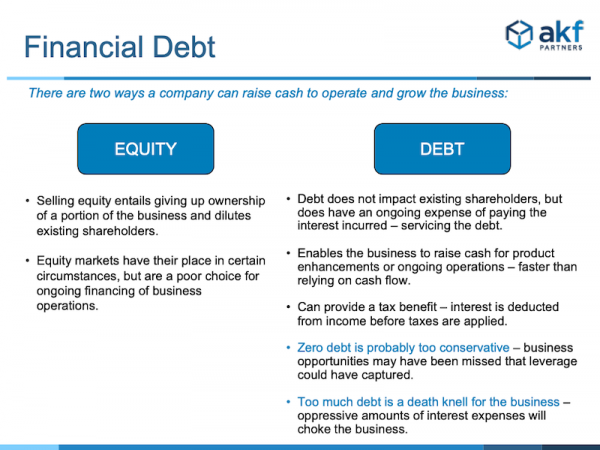
Tech debt operates in the same manner. Companies use tech debt to defer performing work on a product. As we develop our minimum viable product, we build a prototype, gather feedback from the market, and iterate. The parts of the product that didn’t meet the definition of minimum or the decisions/shortcuts made during development represent the tech debt that was taken on to get to the MVP. This is the debt that we must service in later iterations. In fact, our definition of done must include the servicing of the resulting tech debt. Taking on tech debt early can pay big dividends by getting your product to market faster. However, like financial debt, you must service the interest. If you don’t, you will begin to see scalability and availability issues. At that point, refactoring the debt becomes more difficult and time critical. It begins to affect your customers’ experience.
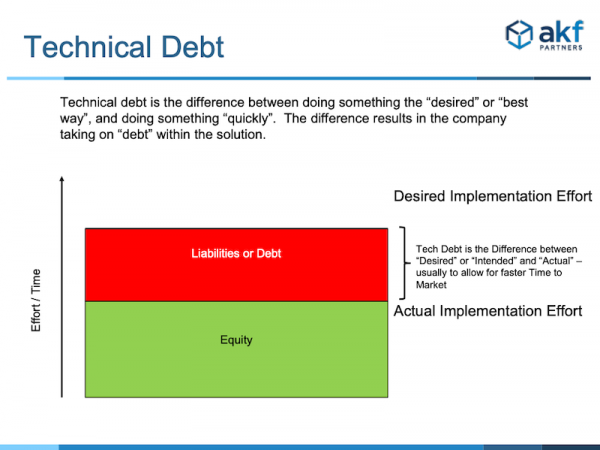
Many development teams have a hard time convincing leadership that technical debt is a worthy use of their time. Why spend time refactoring something that already “works” when you could use that time to build new features customers and markets are demanding now? The danger with this philosophy is that by the time technical debt manifests itself into a noticeable customer problem, it’s often too late to address it without a major undertaking. It’s akin to not having a disaster recovery plan when a major availability outage strikes. To get the business on-board, you must make the case using language business leaders understand – again this is often financial in nature. Be clear about the cost of such efforts and quantify the business value they will bring by calculating their ROI. Demonstrate the cost avoidance that is achieved by addressing critical debt sooner rather than later - calculate how much cost would be in the future if the debt is not addressed now. The best practice is to get leadership to agree and commit to a certain percentage of development time that can be allocated to addressing technical debt on an on-going basis. If they do, it’s important not to abuse this responsibility. Do not let engineers alone determine what technical debt should be paid down and at what rate – it must have true business value that is greater than or equal to spending that time on other activities.
Just as with debt that a company assumes, in and of itself, technical debt is not bad. It can be looked at as a leveraging tool to optimize the technology resources in the short term - delaying a hardware tech refresh or the release date for HTML 5. Delaying attention to address technical issues allows greater resources to be focused on higher priority endeavors. The absence of technical debt probably means missed business opportunities– use technical debt as a tool to best meet the needs of the business. However, excessive technical debt will cause availability and scalability issues, and can choke business innovation (too much engineering time dealing with debt rather than focusing on the product).
Develop a technology balance sheet and profit and loss (income) statement to discuss tech debt with the business in a manner they understand – finance. Let’s first look at the balance sheet, where Assets = Liabilities + Equity. Our assets are the engineering time spent creating the product. Liabilities are the principle of the tech debt (i.e. the difference between “desired” and “actual.” Equity is the remainder, or the engineering resources spent creating the product while not contributing to tech debt.
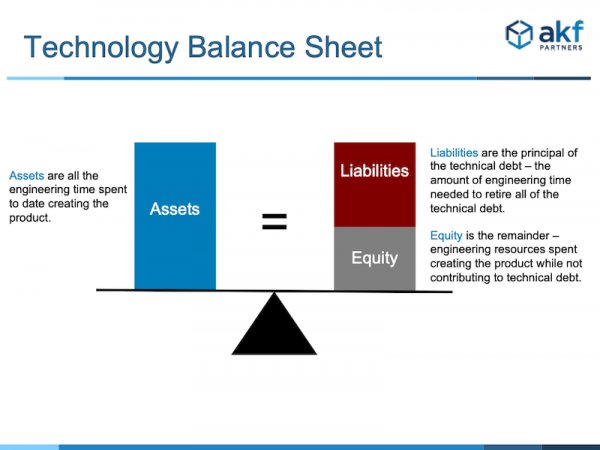
Here is an example of a technology balance sheet:
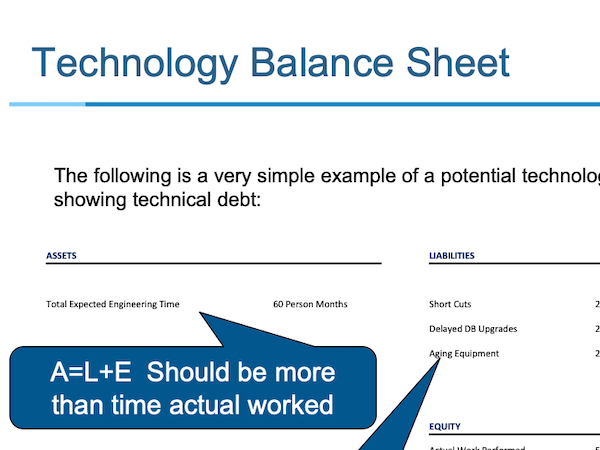
To further the financial analogy, we need to have a technology P&L statement. Here, the interest on tech debt is the difficulty or increased level of effort in modifying something in subsequent releases. This manifests as a reduction in developer productivity per value created. The more debt you take on or less principle you pay down, the higher your interest payment becomes, and the cost to the organization.

Dedicating resources on an ongoing basis to service technical debt can be a challenging discussion with the business. Resources are always limited and employing them in the manner which best benefits the business is a critical business priority decision. Similar to the notion of debt within business, you should never take on technical debt without a plan to pay the interest (increased future cost of development) and principal (fixing the difference between appropriate and as-is). Relating technical debt to financial debt can help those outside of your technology organization grasp the concept and understand the need to keep technical debt under control.
One way to make the concept of debt real is to estimate, for any debt item, the amount of “interest” one will need to pay in the future to modify the solution in question.
- For the benefit of time to market, you decide to “hard code” a number of “display strings” that you’d rather set aside in a resource file to modify and translate later.
- You save 2 weeks of development time, creating a 2-week liability on your balance sheet. You have a 2-week principal to fix.
- You estimate that for all future string modifications (or translations) it will take an additional day of development. Your interest is 1 day, payable for each modification.
Example:
Just as retiring all financial liabilities at once does not make good business sense, trying to wipe out technical debt in one fell swoop is a bad idea. Continuous service to the technical debt is required to prevent technical liabilities from wiping out technical equity. An informed decision to increase debt service to reduce the principal will result in more productive product development time (smaller debt requires less on-going service). A short-term decision to reduce tech debt service in favor of a critical product launch may be viable if not used often. Keep track of both your principal (balance sheet) and your interest payments (income statement). Use these to help your business partners with debt related decisions.
Do NOT mix the cost of defects, or other infrastructure and software mistakes with tech debt. Doing so creates two very big problems:
- It becomes harder for the technology team to learn from past mistakes. Mistakes are mistakes and we should use them as learning opportunities. Debt is taken thoughtfully. Track them separately and treat them differently.
- Using the debt term for non-debt related items, will lower the level of trust between you and the business. Businesses don’t for instance “mistakenly” take on debt. Mixing these terms can cause relationship problems.
Additionally, be clear about how you define technical debt, so time spent paying it down is not commingled with other activities. Bugs in your code are not technical debt. Refactoring your code base to make it more scalable, however, would be. A good test is to ask if the path you chose was a conscious or unconscious decision. Meaning, if you decided to go in one direction knowing that you would later need to refactor. You are making a specific decision to do or not to do something knowing that you will need to address it later. Bugs are found in sloppy code, and that is not tech debt, it is just bad code.
Prioritizing Tech Debt
So how do you decide what tech debt should be addressed and how do you prioritize? If you have been tracking work with Agile storyboards and product backlogs, you should have an idea where to begin. Also, if you track your problems and incidents like we recommend, then this will show elements of tech debt that have begun to manifest themselves as scalability and availability concerns. Set a budget and begin paying down the debt. If you are working on less 12%, you are not spending enough effort. If you are spending over 25%, you are probably fixing issues that have already manifested themselves, and you are trying to catch up. Setting an appropriate budget and maintaining it over the course of your development efforts will pay down the interest and help prevent issues from arising.
Taking on technical debt to fund your product development efforts is an effective method to get your product to market quicker. But, just like financial debt, you need to take on an appropriate amount of tech debt that you can service by making the necessary interest and principle payments to reduce the outstanding balance. Failing to set an appropriate budget will result in a technical “bankruptcy” that will be much harder to dig yourself out of later.
Tech Debt Takeaways
Here is a list of our tech debt takeaways:
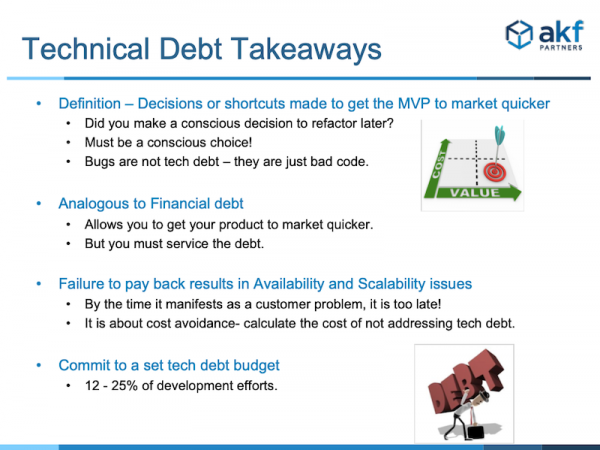
Want help reducing your tech debt? We can help.